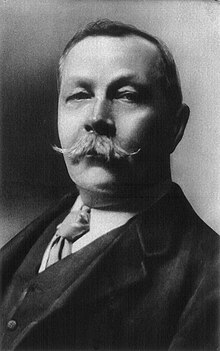About the Book: "The Man with the Twisted Lip", one of the 56 short Sherlock Holmes stories written by British author Sir Arthur Conan Doyle, is the sixth of the twelve stories in The Adventures of Sherlock Holmes. The story was first published in the Strand Magazine in December 1891. Doyle ranked "The Man with the Twisted Lip" sixteenth in a list of his nineteen favourite Sherlock Holmes stories.
About the Author: Arthur Ignatius Conan Doyle was born on 22 May 1859 at 11 Picardy Place, Edinburgh, Scotland. From 1876 to 1881, he studied medicine at the University of Edinburgh, including a period working in the town of Aston (now a district of Birmingham) and in Sheffield, as well as in Shropshire at Ruyton-XI-Towns. While studying, Doyle began writing short stories. His earliest extant fiction, "The Haunted Grange of Goresthorpe", was unsuccessfully submitted to Blackwood's Magazine. His first published piece "The Mystery of Sasassa Valley", a story set in South Africa, was printed in Chambers's Edinburgh Journal on 6 September 1879. On 20 September 1879, he published his first non-fiction article, "Gelsemium as a Poison" in the British Medical Journal. In 1882 he joined former classmate George Turnavine Budd as his partner at a medical practice in Plymouth, but their relationship proved difficult, and Doyle soon left to set up an independent practice. Arriving in Portsmouth in June of that year with less than £10 (£900 today) to his name, he set up a medical practice at 1 Bush Villas in Elm Grove, Southsea. The practice was initially not very successful. While waiting for patients, Doyle again began writing stories and composed his first novels, The Mystery of Cloomber, not published until 1888, and the unfinished Narrative of John Smith, which would go unpublished until 2011. He amassed a portfolio of short stories including "The Captain of the Pole-Star" and "J. Habakuk Jephson's Statement", both inspired by Doyle's time at sea, the latter of which popularized the mystery of the Mary Celeste and added fictional details such as the perfect condition of the ship (which had actually taken on water by the time it was discovered) and its boats remaining on board (the one boat was in fact missing) that have come to dominate popular accounts of the incident. Doyle struggled to find a publisher for his work. His first significant piece, A Study in Scarlet, was taken by Ward Lock Co. on 20 November 1886, giving Doyle £25 for all rights to the story. The piece appeared later that year in the Beeton's Christmas Annual and received good reviews in The Scotsman and the Glasgow Herald. The story featured the first appearance of Watson and Sherlock Holmes, partially modeled after his former university teacher Joseph Bell. Doyle wrote to him, "It is most certainly to you that I owe Sherlock Holmes ... Round the center of deduction and inference and observation which I have heard you inculcate I have tried to build up a man." Robert Louis Stevenson was able, even in faraway Samoa, to recognize the strong similarity between Joseph Bell and Sherlock Holmes: "My compliments on your very ingenious and very interesting adventures of Sherlock Holmes. ... Can this be my old friend Joe Bell?" Other authors sometimes suggest additional influences—for instance, the famous Edgar Allan Poe character C. Auguste Dupin. A sequel to A Study in Scarlet was commissioned and The Sign of the Four appeared in Lippincott's Magazine in February 1890, under agreement with the Ward Lock company. Doyle felt grievously exploited by Ward Lock as an author new to the publishing world and he left them. Short stories featuring Sherlock Holmes were published in the Strand Magazine. Doyle first began to write for the 'Strand' from his home at 2 Upper Wimpole Street, now marked by a memorial plaque. In this period, however, Holmes was not his sole subject and in 1893, he collaborated with J.M. Barrie on the libretto of Jane Annie. Doyle was found clutching his chest in the hall of Windlesham Manor, his house in Crowborough, East Sussex, on 7 July 1930. He died of a heart attack at the age of 71. His last words were directed toward his wife: "You are wonderful." At the time of his death, there was some controversy concerning his burial place, as he was avowedly not a Christian, considering himself a Spiritualist. He was first buried on 11 July 1930 in Windlesham rose garden. He was later reinterred together with his wife in Minstead churchyard in the New Forest, Hampshire. Carved wooden tablets to his memory and to the memory of his wife are held privately and are inaccessible to the public. That inscription reads, "Blade straight / Steel true / Arthur Conan Doyle / Born May 22nd 1859 / Passed On 7th July 1930." The epitaph on his gravestone in the churchyard reads, in part: "Steel true/Blade straight/Arthur Conan Doyle/Knight/Patriot, Physician, and man of letters". Undershaw, the home near Hindhead, Haslemere, south of London, that Doyle had built and lived in between October 1897 and September 1907, was a hotel and restaurant from 1924 until 2004. It was then bought by a developer and stood empty while conservationists and Doyle fans fought to preserve it. In 2012 the High Court ruled that the redevelopment permission be quashed because proper procedure had not been followed. A statue honours Doyle at Crowborough Cross in Crowborough, where he lived for 23 years. There is also a statue of Sherlock Holmes in Picardy Place, Edinburgh, close to the house where Doyle was born.
My Review: Well written, another excellent plot on the Sherlock Holmes short story series: Dr Watson is called upon late at night by a female friend of his wife. Her husband has been absent for several days and, as he is an opium addict, she is sure he has been indulging in a lengthy drug binge in a dangerous East End opium den. Frantic with worry, she seeks Dr. Watson's help in fetching him home. Watson does this, but he also finds his friend Sherlock Holmes in the den, disguised as an old man, trying to extract information about a new case from the addicts in the den.
Mr. Neville St. Clair, a respectable and punctual country businessman, has disappeared. Making the matter even more mysterious is that Mrs. St. Clair is quite sure that she saw her husband at a second-floor window of the opium den, in Upper Swandam Lane, a rather rough part of town near the docks. He withdrew into the window immediately, and Mrs. St. Clair is quite sure that there was something very wrong.
Naturally, she tries to enter the building, but her way was blocked by the opium den's owner, a Lascar. She quickly fetches the police, but they cannot find Mr. St. Clair. The room, in whose window she saw her husband, is that of a dirty, disfigured beggar, well known to the police, by the name of Hugh Boone. The police are about to put this report down as a mistake of some kind when Mrs. St. Clair spots and identifies a box of wooden bricks that her husband said he would buy for their son. A further search turns up some of her husband's clothes. Later, his coat, with the pockets full of several pounds' worth of pennies and halfpennies, is found in the Thames just below the building.
The beggar is arrested and locked up at the police station, and Holmes initially is quite convinced that Mr. St. Clair has been the unfortunate victim of murder. However, several days after Mr. St. Clair's disappearance, his wife receives a letter in his own writing. The arrival of this letter forces Holmes to reconsider his conclusions, leading him eventually to an extraordinary solution. Taking a bath sponge to the police station in a Gladstone bag, Holmes washes Boone's still-dirty face, causing his face to be revealed — the face of Neville St. Clair! Upon Mr. St. Clair's immediate confession, this solves the mystery, and also creates a few problems.
It seems that Mr. St. Clair has been leading a double life, one of respectability, and the other as a beggar. In his youth, he had been an actor before becoming a newspaper reporter. In order to research an article, he had disguised himself as a beggar for a short time, during which he earned a very large amount of money. Later in his life, he returned to the street to beg for several days in order to pay a large debt. Given a choice between his newspaper salary and his high beggar earnings, he eventually became a professional beggar. His takings were large enough that he was able to establish himself as a country gentleman, marry well, and begin a respectable family. His wife never knew what he did for a living, and Holmes agrees to preserve Mr. St. Clair's secret as long as no more is heard of Hugh Boone.
I recommend this book to the permanent library of all readers who appreciate a good mystery story or enjoy Sherlock Holmes tales.
If you read this review, feel free to leave a message.



No comments:
Post a Comment